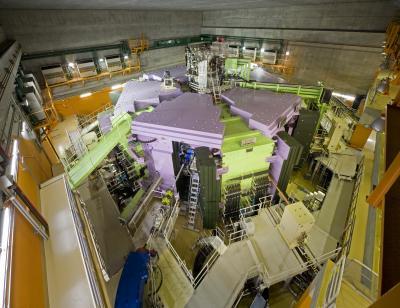Researchers have come one step closer to understanding unstable atomic nuclei.
The protons and neutrons inside the atomic nucleus exhibit shell structures in a manner similar to electrons in an atom. For naturally stable nuclei, these nuclear shells fill completely when the number of protons or the number of neutrons is equal to the 'magic' numbers 2, 8, 20, 28, 50, 82 or 126. But not always. For exotic nuclei, 28 is not a magic number of neutrons. Traditional magic numbers, which were once thought to be common for all nuclei, can change in unstable, radioactive nuclei that have a large imbalance of protons and neutrons.
A team of researchers from has provided evidence for a new nuclear magic number in the unstable, radioactive calcium isotope 54Ca. They show that 54Ca is the first known nucleus with 34 neutrons (N) where N = 34 is a magic number. The work may have value for improving understanding nucleosynthesis - how heavy elements are formed from lighter ones inside stars and supernovae.
The current focused on 54Ca, which has 20 protons and 34 neutrons in its nucleus, which they were able to study at the Radioactive Isotope Beam Factory (RIBF) at RIKEN, which produces the highest intensity radioactive beams available in the world.

Schematic illustration highlighting the attractive interaction between the proton πf7/2 and neutron νf5/2 single-particle orbitals for N = 34 isotones. Credit and link: doi:10.1038/nature12522
In their experiment, a radioactive beam composed of scandium-55 and titanium-56 nuclei travelling at around 60% of the speed of light, was selected and purified by the BigRIPS fragment separator, part of the RIBF. The radioactive beam was focused on a reaction target made of beryllium. Inside this target, projectile fragmentation of the 55Sc and 56Ti nuclei occurred, creating numerous new radioactive nuclei, some in excited states.
The researchers measured the energy of the γ rays emitted from excited states of the radioactive nuclei using an array of 186 detectors surrounding the reaction target.
The results of the experiment indicate that 54Ca's first excited state lies at a relatively high energy, which is characteristic of a large nuclear shell gap, thus indicating that N = 34 in 54Ca is a new magic number, as predicted theoretically by the University of Tokyo group in 2001. By conducting a more detailed comparison to nuclear theory the researchers were able to show that the N = 34 magic number is equally as significant as some other nuclear shell gaps.

The Superconducting Ring Cyclotron (SRC) at RIKEN RIBF, where the experiments were carried out. Credit: RIKEN
"Our new measurement provides key data for the understanding of neutron-rich nuclei and will help pin down the treatment of nuclear forces in systems far from stability," explains lead author David Steppenbeck. "Enriching our knowledge of the structures of highly unstable nuclei and the nucleon-nucleon forces that drive nuclear shell evolution and the appearance or disappearance of the nuclear magic numbers in radioactive nuclei plays an important role in understanding astrophysical processes such as nucleosynthesis in stars."
Citation: D. Steppenbeck, S. Takeuchi, N. Aoi, P. Doornenbal, M. Matsushita, H. Wang, H. Baba, N. Fukuda, S. Go, M. Honma, J. Lee, K. Matsui, S. Michimasa, T. Motobayashi, D. Nishimura, T. Otsuka, H. Sakurai, Y. Shiga, P.-A. Söderström, T. Sumikama, H. Suzuki, R. Taniuchi, Y. Utsuno, J. J. Valiente-Dobón and K. Yoneda, 'Evidence for a new nuclear ‘magic number’ from the level structure of 54Ca', Nature 502, 207–210 10 October 2013 doi:10.1038/nature12522





Comments